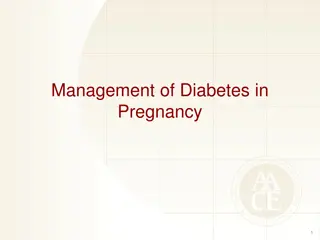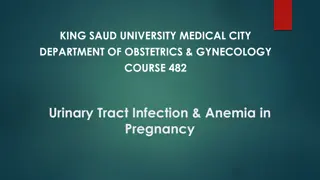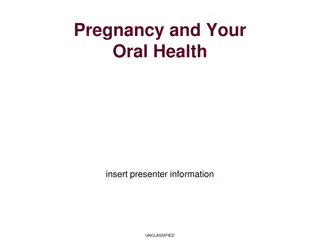Transvers & Oblique Lie in Pregnancy
Transvers & oblique lie in pregnancy, also known as shoulder presentation, can pose risks such as obstructed labor and fetal death. Learn about diagnosis, treatment options, and potential complications associated with this positioning.
Download Presentation

Please find below an Image/Link to download the presentation.
The content on the website is provided AS IS for your information and personal use only. It may not be sold, licensed, or shared on other websites without obtaining consent from the author.If you encounter any issues during the download, it is possible that the publisher has removed the file from their server.
You are allowed to download the files provided on this website for personal or commercial use, subject to the condition that they are used lawfully. All files are the property of their respective owners.
The content on the website is provided AS IS for your information and personal use only. It may not be sold, licensed, or shared on other websites without obtaining consent from the author.
E N D
Presentation Transcript
Transvers & oblique lie Dr. Ali F. Al-Assadi Prof. of Obstetrics & Gynecology
Transvers & oblique lie (shoulder presentation) The fetus lies with its long axis transverse or oblique in the uterus, when the point of the shoulder is usually the presenting part. Occur 1:325-500. Etiology: Multiparous with lax abdominal wall. Contracted pelvis, placenta previa & pelvic tumors. Prematurity. Polyhydramnios IUD Twin Abnormal uterine shape.
Diagnosis Positions: dorso-anterior (commonest), dorso-posterior, dorso superior & dorso-inferior. Diagnosis: A- abdominal examination: the uterus appears asymmetrical, broader than usual with the fundus lower than the expected for date; on palpation the head is in one of the iliac fossae, no presenting part is felt over the brim.
Diagnosis B- Vaginal examination: high presenting part, the membranes rupture early in labour& when the cervix dilated an arm or loop of cord may be prolapsed, the acromion process & adjacent ribs may also be felt, the arm should be differentiated from a leg by the absence of heel & abduction of the thumb. C- X-ray & ultra sound.
Course of labour The fetus can t be born vaginally unless it is macerated or very premature. There is no mechanism of labor & untreated cases will end in obstructed labor & fetal death. Neglected cases can end with rupture uterus.
Treatment During early labor: before the membranes rupture, ECV may correct the abnormality. Followed by amniotomy & uterine stimulation to maintain longitudinal lie. If oblique or transverse lie persist in labor CS is performed. In cases of T-lie of the second twin with intact membranes & full cx dilatation internal podalic version may be attempted in which the fetal legs are pulled down & followed by breech extraction.
Treatment Late in labor with impacted shoulder: if with dead fetus CS is the safest procedure, rarely decapitation is done in areas with no facilities for CS.
Compound presentation: Occur in 1:650- 1250; it includes cases of cephalic presentation when one or more limbs lie alongside & presented with the head & also breech presentation when one or both arms presented with the breech.
Etiology Contracted pelvis & pelvic tumors. Polyhydramnios. Deflection of the head. Dead macerated fetus. The commonest is head + hand (75%).
Management Diagnosis: Is easy after the membranes are ruptured. Management: exclude congenital anomalies, CPD & contracted pelvis, finally cord prolapse if the fetus is a live. In general expectant treatment is chosen as in most of the cases the extremity of the limb will recede as the presenting part descends, active treatment is necessary in cases of cord prolapse with live fetus or CPD when CS is indicated.
Prolapse & presentation of the umbilical cord Occur 1: 200-300 deliveries. Whilst the membranes remain intact, the condition is that of presentation, which becomes cord prolapse when the sac rupture. The fetal mortality is lower in cases of cord presentation compare to cord prolapse.
Aetiology Etiology: Malpresentation & nonengagement of the presenting part. Prematurity. Operative maneuver. Multiparity. Abnormal cord eg. Long cord or low placental insertion.
Diagnosis It should be suspected if there is fetal heart rate variation (variable deceleration). One may feel coils of cord within the forewater before the membranes rupture in such presentation it is important to keep the membranes intact while preparing for CS. In prolapse coils of cord are felt within the vagina & in this situation, cx dilation, level of the presenting part & presentation must be noted as well as pulsation in the cord.
Management Vaginal delivery is indicated if the fetus is dead or has lethal congenital anomalies. A trial of labor with instrumental delivery may also be allowed if the cx is 8 cm dilated with deeply engaged head. Cases other than the above must be treated as follow:
Emergency measures: prevent cord compression by postural treatments that involve keeping the fingers in the vagina & placing the patient in Sims or Trendlenburg s position. It has been suggested that rapid forceful instillation of 500- 700 ml of saline into the bladder via a Foley s catheter is also effective. The cord should be replaced within the warm, moist vagina, so preventing the vasospasm that results from cold & local irritation.
deliver the fetus by CS. Definitive treatment Is to deliver the fetus by CS.





























